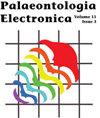Paleoclimate and paleoecology of the Upper Oligocene Tehuacán Formation, Puebla State, Mexico, as determined from wood anatomical characters
IF 1.5
4区 地球科学
Q1 Earth and Planetary Sciences
引用次数: 2
Abstract
Climatic conditions that prevailed during the deposition time of the Tehuacán Formation, Mexico (upper Oligocene) are proposed based on a previous model using wood anatomical characters. Different paleoclimatic variables were calculated, and the anatomical characteristics of the Tehuacán Formation paleoflora were compared with the characteristics of other extant and fossil plant communities to infer water conductive capacities of the Tehuacán Fm. plants. The paleoclimatic inference suggests that the environmental conditions under which the fossilized plants of the Tehuacán Fm. grew were seasonally warm and humid. Statistical analysis and the presence of growth rings in some woods suggest that the paleoflora of the Tehuacán Fm. were similar to extant tropical communities such as tropical semi-deciduous forests and the tropical deciduous forests, most probably representing a transitional community: containing plants that were efficient in transporting water like those in the tropical wet forests, but with phenological adaptations typical of drier tropical forests. Marco A. Rubalcava-Knoth. Posgrado en Ciencias Biológicas, Instituto de Geología, UNAM; Ciudad Universitaria, Circuito de la Investigación Científica, Copilco El Alto, Coyoacán; 04510 Mexico D.F., Mexico. paleoplantas@gmail.com Sergio R.S. Cevallos-Ferriz. Departamento de Paleontología, Instituto de Geología, UNAM; Ciudad Universitaria, Circuito de la Investigación Científica, Copilco El Alto, Coyoacán; 04510 Mexico D.F., Mexico. scrscfpb@unam.mx墨西哥普埃布拉州上渐新世Tehuacán组的古气候和古生态——以木材解剖特征为依据
根据先前使用木材解剖特征的模型,提出了墨西哥Tehuacán组沉积时期(渐新世晚期)的气候条件。计算了不同的古气候变量,并将Tehuacán组古植物群的解剖特征与其他现存和化石植物群落的特征进行了比较,以推断Tehuacón组植物的导水能力。古气候推断表明,特华坎组植物化石生长的环境条件是季节性温暖潮湿的。统计分析和一些树林中生长环的存在表明,特华坎组的古植物群与现存的热带群落相似,如热带半落叶林和热带落叶林,很可能代表了一个过渡群落:包含像热带湿林中那样高效运水的植物,但具有典型的干旱热带森林的酚类适应性。Marco A.Rubalcava Knoth。Posgrado en Ciencias Biológicas,UNAM地质研究所;Ciudad Universitaria、Circuito de la Investigación Científica、Copilco El Alto、Coyoacán;04510墨西哥D.F.,墨西哥。paleoplantas@gmail.comSergio R.S.Cevallos Ferriz。古生物学部,地质研究所,UNAM;Ciudad Universitaria、Circuito de la Investigación Científica、Copilco El Alto、Coyoacán;04510墨西哥D.F.,墨西哥。scrscfpb@unam.mx
本文章由计算机程序翻译,如有差异,请以英文原文为准。
求助全文
约1分钟内获得全文
求助全文
来源期刊

Palaeontologia Electronica
地学-古生物学
CiteScore
3.60
自引率
0.00%
发文量
20
审稿时长
>12 weeks
期刊介绍:
Founded in 1997, Palaeontologia Electronica (PE) is the longest running open-access, peer-reviewed electronic journal and covers all aspects of palaeontology. PE uses an external double-blind peer review system for all manuscripts. Copyright of scientific papers is held by one of the three sponsoring professional societies at the author''s choice. Reviews, commentaries, and other material is placed in the public domain. PE papers comply with regulations for taxonomic nomenclature established in the International Code of Zoological Nomenclature and the International Code of Nomenclature for Algae, Fungi, and Plants.
 求助内容:
求助内容: 应助结果提醒方式:
应助结果提醒方式:


